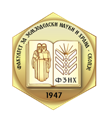EVALUATION OF FREQUENTLY GROWN LEAK LANDRACES IN NORTH MACEDONIA
Клучни зборови:
pseudostem, leaf number, shaft mass, agronomic value.Апстракт
In North Macedonia, there is a long tradition of growing leek. The most grown are those with long shaft (pseudostem) or kamus type of leeks. The study aimed to evaluate three local landraces of leek with long shafts (pseudostem): Kumanovski, Veleski, and Strumicki. The experiment was set up in the village of Dobrejci near Strumica, during the season of 2019. A single experimental plot was 12 m2 with a density of 400 plants per plot organized in a complete randomized block design in four replications. During the vegetation period the plant height (cm), the shaft thickness (pseudostem) (mm), leaves number in the shaft (pseudostem), the plant mass (g), length of the shaft (pseudostem) (cm), the shaft mass (pseudostem) (g) and total yield (t ha-1) were measured. According to the results, the thickest shaft (pseudostem) (32.38 mm), the highest number of leaves in the shaft (pseudostem) (11.78), the highest plant mass (460.26g), the highest shaft mass (pseudostem) (285.53 g) and total yield (95.18 t ha-1) were obtained from Kumanovski leek landrace. The highest plants (87.74 cm) had Veleski leek landrace while the longest shaft (pseudostem) (36.35 cm) was observed in the Strumicki leek landrace. It can be concluded that even grown in different climate conditions from its origin, the Kumanovski leek landrace obtained the best results. Further research on these landraces should be taken into consideration.



